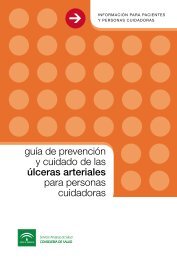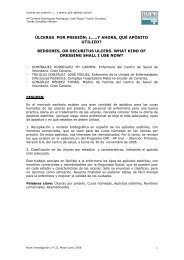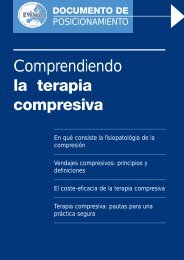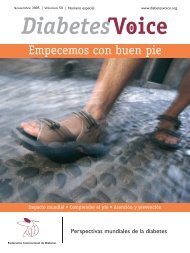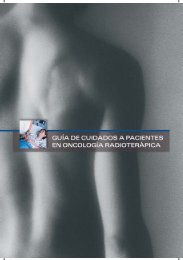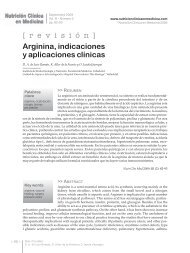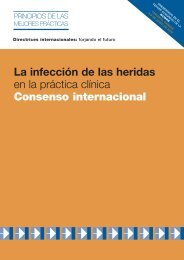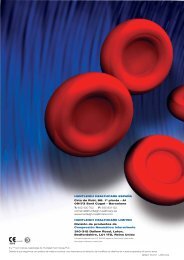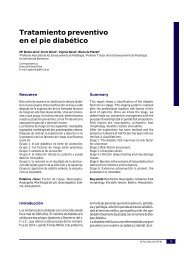Descargar - Úlceras.net
Descargar - Úlceras.net
Descargar - Úlceras.net
- No tags were found...
You also want an ePaper? Increase the reach of your titles
YUMPU automatically turns print PDFs into web optimized ePapers that Google loves.
OPEN SURGERY FOR REVASCULARIZATION OF THE DIABETIC FOOD ■ 85the use of the LSV for lower extremity revascularizationwithout repositioning has beenreported (23). In our experience, we reported65% primary patency at 2 years, in case offirst revascularization.Despite inferior patency rates comparedto GSV, arm vein conduits are generally consideredusable. Lepantalo et al. (24) in a recentseries retrospectively reviewed 290 consecutiveinfrainguinal bypasses for CLI using arm aveins (130) or prosthetic graft (160) inabsence of adequate GSV. The patency ratesat 3 years were significantly better in the armvein group for the infrapopliteal revascularization.Pomposelli et al. (25) also compared theeffectiveness of all-autogenous arm veinbypass grafts (506 bypasses) with that of prostheticgrafts (234). The 1-year primary patencyrates for BK femoro-popliteal grafts were92.9% ± 5.1% (arm vein) and 83.4% ± 8.0%(prosthetic); the 3-year rates were 72.8% ±10.1% (arm vein) and 55.5% ± 12.1% (prosthetic)(P .05). The 1-year limb salvage ratesfor BK femoro-popliteal grafts were 100%(arm vein) and 91.3% ± 7.0% (prosthetic); the3-year rates were 94.7% ± 7.3% (arm vein)and 75.3% ± 14.6% (prosthetic) (P = NS).These experiences showed that arm veinsare an excellent alternative of the GSV, comparedwith prosthetic graftsA particular concern for the arm veins arethe fragility and difficulty in handling duringthe preparation. In addition, frequently, multiplesegments may be necessary to attain sufficientconduit length to perform a bypassgraft. These concerns have led several Authorsto promote the use of prosthetic grafts forarterial reconstruction.VARICOSE VEINSWe stress the use of non-optimal veingraft material to avoid prosthetic bypass,which produces bad results in terms of patencyand limb salvage. The midterm incidence offocal stenosis due to intimal hyperplasia is 20to 35%.Varicose dilation may involve an isolatedsegment or the entire vein. The basilic vein isusually thinly walled and has a large diameter;therefore, is typically prone to developaneurysm or other graft problems at a rate ofup to 55%. These situations are usually a contraindicationto autologous vein grafting dueto the increased formation of intimal hyperplasiaand dilatation which could lead toaneurism formation and thrombus apposition.Attention to this problem is crucial inyounger patients undergoing vein bypass graft.Young people have a long life expectancy, andtheir arterialized veins frequently undergoprogressive dilatation.The external sheath acts to contain thegraft, prevents turbulent blood flow, and significantlyimproves long-term patency ratescompared to unsupported grafts.Polyester external mesh is a valid methodto perform bypass with autologous material,as ectatic or varicose veins.In our experience we used external meshto prevent the dilatation of bypass in pre -sence of an ectatic or varicose autologousmaterial (26).A multifilament polyester mesh was utilizedin 21 patients (7.3%) of 289 patientstreated in the same interval of time. It was anopen, porous prosthesis with a honeycomblikestructure allowing the intraoperativeexternal scaffolding of autologous veins. Thechoice of external mesh was based on themean diameter evaluated at echo-scan.Only the suboptimal dilated tract of veinswas covered in an attempt to maintain in-situbypass whenever possible. The external meshwas fixed with some points at the anastomosisto avoid curling of the coating and possibleformation of stenosis.Primary, assisted patency, and amputationfreesurvival rates at 24 months were 57.1 %(SE ± 3.9), 81% (SE ± 3.2), and 85.7% (SE ±2.8), respectively, comparable to those of previousstudies of infrainguinal revascularizationin patients with no vein varicosities.Although the polyester mesh can beprone to infections, especially when used inCLI patients with extensive gangrene, we did





